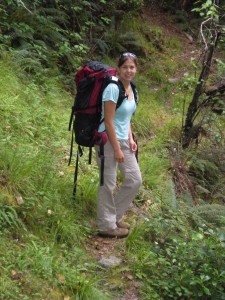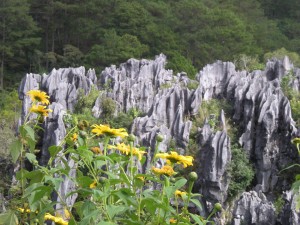Well, I’ve moved into elastic waistbands about four decades earlier than expected. I was skeptical about bringing jeans from New Zealand to the tropics. Arriving at my hosts’ house in 80 degrees and 90% humidity, I immediately removed them. For good. That left me with my light-weight, zip-off cargo pants and a pair of leggings. Good enough! Until laundry day when I am left with nothing to cover my bum (providing I want all my clothes cleaned).

These light-weight zip-offs have seen thousands of trail and travel miles in the past three years. Oh, and they have elastic panels at the hips.
I searched the second-hand markets high and low for a pair of lightweight trousers (I’m a traveler, folks. That means I am more dirty than clean most of the time and generally have no need for flash clothing.) I was too girthy and too tall for all the women’s clothing, and too skinny and short for all the men’s clothing. Enter the elasic waistband rack.
I giggled to myself about having to resort to this fashion faux pas. And then realized that my cargos have elastic panels at my hip bones. And of course the leggings are pure elastic. Which means I am a geriatric fashionista about forty-two years sooner than I thought I would be.
I promptly put my new light-weight, olive green (I can’t escape earth tones), elastic-waistband slacks to the test in the mountain town of Sagada. As promised, the road there snaked along precipitous drops for hours. I was so relieved not to be sitting in my assigned seat next to the meanest looking fat man I’ve ever seen that I barely noticed the hardships of the journey. For example — the driver only had two brake-pedal-positions. Fully depressed, and not-in-use. But I didn’t mind pitching forward once every twenty seconds for five hours. Example #2 — it was raining as we left Baguio. The fog filled the deep crevasses that pass as “valleys” here. I couldn’t see down into the abyss for most of the trip. I thought, perhaps, I should count my blessings here. But then I flashed back to the slip-slide-run that I’d done down cobblestones slick with rain on my way to the bus station. So maybe I should say my last words, instead? Example #3 — I can all but guarantee you that your Filipino bus driver was conduct himself like a newly-licensed American teenager with way too much horsepower under his butt. For my driver, this meant furious acceleration on any straight-away — no matter how short — and then slamming on the brakes as we careened around all 984 corners. Obviously, I didn’t really get to nap on this trip.

The sunflowers... but not against the gloomy backdrop I talked about. Getting a bit ahead of myself - this one is in Sagada. Next post.
Highlights were the occasional piece of terrain peaking through the clouds and the yellow sunflowers glowing like stars against the backdrop of grey fog and ubiquitous concrete. This region is known for terraced farming of the steep mountains — a breathtaking accomplishment to behold. Why? Perhaps, as humans are drawn to symmetry (this is a key ingredient in a “pretty” face), seeing order made from the already gorgeous handiwork of mother nature inspires awe.
Obviously I arrived in Sagada in one piece, albeit in the dark. Still, I managed to track down a cheap room at Igorot Inn and an enormous plate of pancit bihon (glass noodles with vegetables) before calling it a night!♣




Twitter Facebook Google+ StumbleUpon Reddit Pinterest